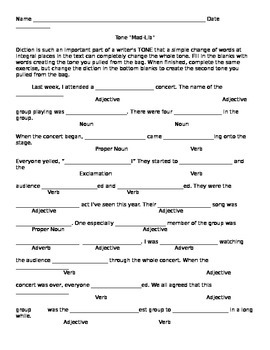Tone: Mad Lib Activity
Electric English
796 Followers
Grade Levels
9th - 11th
Subjects
Resource Type
Standards
CCSSRL.9-10.4
CCSSRL.9-10.5
CCSSRL.9-10.6
CCSSRL.9-10.10
CCSSW.9-10.7
Formats Included
- Word Document File
Pages
1 page
Electric English
796 Followers
Description
From Electric English...
Tone is everything!!!! If a student misinterprets the tone in a piece of writing, then they will likely misinterpret the entire meaning of the piece. The is a short activity meant to introduce your students to the concepts and ideas behind recognizing tone. How does a writer feel about a particular piece of their work? What is their purpose? What do they want you to feel in response to their words? All of these questions and more are relevant to tone...
This is a brief, introductory activity to get your students thinking about how word choice can determine the tone of a piece. But more importantly, how changing just a few words, can sometimes alter the entire meaning and tone of the work. With this activity, they are asked to pull two tone words from a bag and then use those words to inspire a MadLib that they fill in the blanks for.... It is a fun, electrifying way to get your students contemplating the feeling and purpose behind a text.
If you have any questions or observations, please feel free to contact me :)
Tone is everything!!!! If a student misinterprets the tone in a piece of writing, then they will likely misinterpret the entire meaning of the piece. The is a short activity meant to introduce your students to the concepts and ideas behind recognizing tone. How does a writer feel about a particular piece of their work? What is their purpose? What do they want you to feel in response to their words? All of these questions and more are relevant to tone...
This is a brief, introductory activity to get your students thinking about how word choice can determine the tone of a piece. But more importantly, how changing just a few words, can sometimes alter the entire meaning and tone of the work. With this activity, they are asked to pull two tone words from a bag and then use those words to inspire a MadLib that they fill in the blanks for.... It is a fun, electrifying way to get your students contemplating the feeling and purpose behind a text.
If you have any questions or observations, please feel free to contact me :)
Total Pages
1 page
Answer Key
Does not apply
Teaching Duration
30 minutes
Last updated Feb 25th, 2015
Report this resource to TPT
Reported resources will be reviewed by our team. Report this resource to let us know if this resource violates TPT’s content guidelines.
Standards
to see state-specific standards (only available in the US).
CCSSRL.9-10.4
Determine the meaning of words and phrases as they are used in the text, including figurative and connotative meanings; analyze the cumulative impact of specific word choices on meaning and tone (e.g., how the language evokes a sense of time and place; how it sets a formal or informal tone).
CCSSRL.9-10.5
Analyze how an author’s choices concerning how to structure a text, order events within it (e.g., parallel plots), and manipulate time (e.g., pacing, flashbacks) create such effects as mystery, tension, or surprise.
CCSSRL.9-10.6
Analyze a particular point of view or cultural experience reflected in a work of literature from outside the United States, drawing on a wide reading of world literature.
CCSSRL.9-10.10
By the end of grade 9, read and comprehend literature, including stories, dramas, and poems, in the grades 9-10 text complexity band proficiently, with scaffolding as needed at the high end of the range.By the end of grade 10, read and comprehend literature, including stories, dramas, and poems, at the high end of the grades 9-10 text complexity band independently and proficiently.
CCSSW.9-10.7
Conduct short as well as more sustained research projects to answer a question (including a self-generated question) or solve a problem; narrow or broaden the inquiry when appropriate; synthesize multiple sources on the subject, demonstrating understanding of the subject under investigation.


